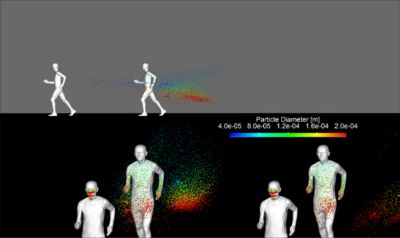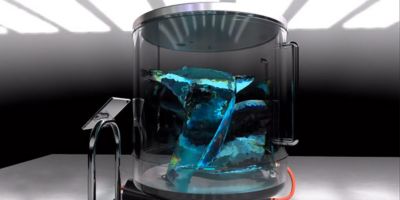-
-
Access Free Student Software
Ansys empowers the next generation of engineers
Students get free access to world-class simulation software.
-
Connect with Ansys Now!
Design your future
Connect with Ansys to explore how simulation can power your next breakthrough.
Countries & Regions
Free Trials
Products & Services
Learn
About
Back
Products & Services
Back
Learn
Ansys empowers the next generation of engineers
Students get free access to world-class simulation software.
Back
About
Design your future
Connect with Ansys to explore how simulation can power your next breakthrough.
Free Trials
ANSYS BLOG
April 7, 2020
Simulations Show How to Reduce the Spread of COVID-19
As the world faces the most aggressive pandemic in a lifetime, many of us are staying indoors wondering when life can get back to normal. During this time, many simulation experts are wondering: How can we help?
These experts are aware that the technology they use every day can help various industries — including the healthcare industry. So, how can they use that technology to help combat COVID-19?
Computer models offer engineers tools to simulate healthcare scenarios that complement standard in vitro and in vivo testing. This virtual modeling method — in silico testing — employs the power of cloud and high-performance computing (HPC), so researchers can:
- See the invisible — down to the particle level for some models
- Perform many tests over a short period of time
- Predict behavioral results using physics
Consider social distancing: Around the world we are being asked to remain about 2 meters, or about 6 feet, apart from others. Simulations can help visualize how sneeze and cough droplets spread between people. These models show that at about 1.8 meters (approximately 6 feet), risk of exposure dips significantly as gravity pulls the droplets out of the air.
To see additional models, view: Facing COVID-19 Challenges With Our Customers and Partners.
How Simulations Help Prevent the Spread of Diseases like COVID-19
A variety of researchers are using simulation to better understand how potentially contaminated droplets propagate and put others at risk. This enables them to better prevent the spreading of droplets.
By running directly behind someone, you put yourself at serious risk of contamination.
As an example, consider the 2 m (6 ft) suggested by national social distancing guidelines and the previously mentioned simulation. Is this always far enough? Ansys partners Bert Blocken and Fabio Malizia at Eindhoven University of Technology and KU Leuven have created a model that suggests that more space is required to avoid the spread of cough droplets between runners and cyclists. Medical practitioners, policymakers and organizations (like the CDC and WHO) can use this information to optimize the social distancing guidelines that protect us.
What about face masks? If an infected person wears one, they can reduce the risk of contaminating others by up to 600%. However, wearing the mask correctly for long periods is irritating — people often move them around, breaking the seal between the face and mask. Simulations can model how adjusting the mask puts medical staff at risk. By sharing these visuals, medical personnel and others may be encouraged to stop touching their masks.
Models can also help the cleaning efforts of those disinfecting and decontaminating facilities. The virus will inevitably end up on surfaces that will need to be cleaned to contain the spread. Simulations performed by Ansys partner InSilicoTrials show how to optimize the decontamination process to ensure rooms are clean.
To watch videos of these simulations, visit: Facing COVID-19 Challenges With Our Customers and Partners.
How Simulations Help Treat Diseases like COVID-19
Simulations can also be used to help optimize the treatment of those that have already contracted the disease.
For instance, the medical industry uses virtual models to optimize the design of ventilators. In fact, simulation is the most effective way to accelerate ventilator development so they are more readily available to those in need.
Simulation can help engineers ensure that large-scale reactors, available to produce billions of vaccines, produce the same output as lab-scale reactors.
Simulations can also help the development of new drugs. Hopefully, we will soon identify and approve a vaccine to combat COVID-19. The next challenge will be to scale up the production of the vaccine from laboratory to industrial. Drug companies can use simulation models to scale up production within a virtual environment, so they can get it right the first time in the real world.
Once researchers discover treatments manufacturers can produce, the next challenge is designing delivery systems. Simulation can help here as well. For instance, if the treatment is to be delivered through an inhaler, medical companies can use models to improve the inhaler’s design — as done by Ansys partner Dr. Yu Feng's Computational Biofluidics and Biomechanics Laboratory at Oklahoma State University.
Simulation can ensure that a virtual delivery system, which sends enough medication to a virtual lung, will operate as expected when manufactured and deployed on humans. Once the delivery system is created, these models can be used to help train physicians and nurses.
We have only skimmed the surface on how in silico tests can help prevent and treat COVID-19. To learn more, and see some of these simulations in action, please visit: Facing COVID-19 Challenges With Our Customers and Partners.
Any and all ANSYS, Inc. brand, product, service and feature names, logos and slogans such as Ansys are registered trademarks or trademarks of ANSYS, Inc. or its subsidiaries in the United States or other countries.


